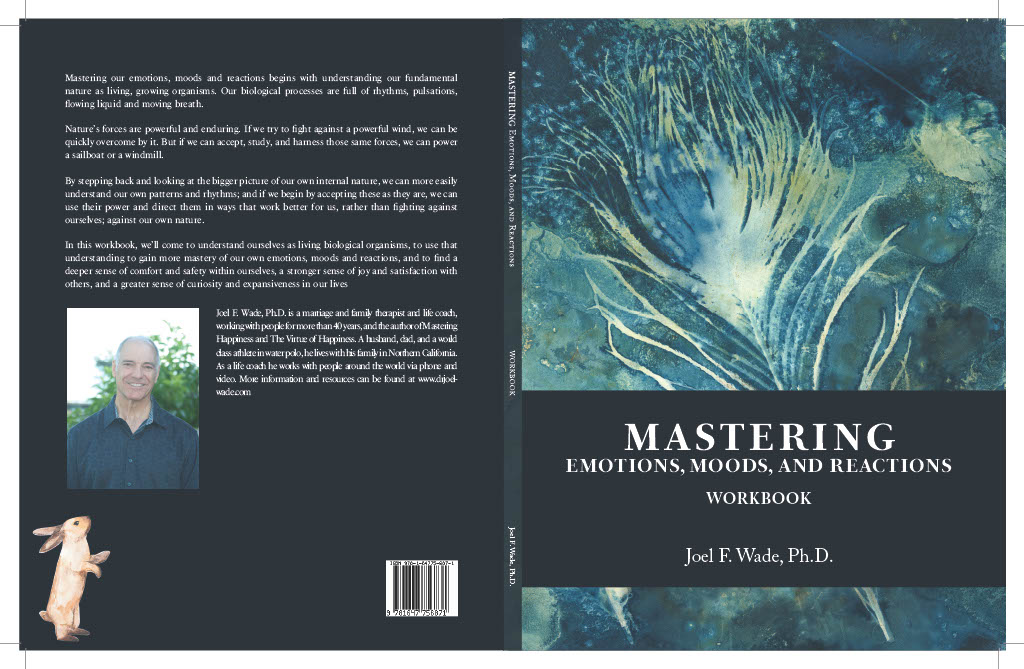(This is from the introduction to my book, Mastering Emotions, Moods, and Reactions)
Mastering our emotions, moods and reactions begins with understanding our fundamental nature as living, growing organisms. Our biological processes are full of rhythms, pulsations, flowing liquid and moving breath. Nature’s forces are powerful and enduring. If we try to fight against a powerful wind, we can be quickly overcome by it. But if we can accept, study, and harness those same forces, we can power a sailboat or a windmill. By stepping back and looking at the bigger picture of our own internal nature, we can more easily understand our own patterns and rhythms; and if we begin by accepting these as they are, we can use their power and direct them in ways that work better for us, rather than fighting against ourselves; against our own nature.
We begin our exploration with orienting to our biological nature.
From this perspective we can begin to make sense of our flowing emotions, our changing moods, and our sudden and intense reactions.
Distinguishing these three qualities from one another can help us learn what to do with each, with much more clarity than when they’re all thrown together as one experience.
Our emotions are more recent, connected with language, and useful primarily for self-reflection and growth. We’ll explore how to use our emotions in ways that allow us to learn from experiences that anger, hurt, frighten, or delight us so that we can function better in the future.
Our moods are more primitive and move more slowly. They have more to do with energy – raising our mood to meet a challenge or seize an opportunity, or lowering our mood when we suffer a loss, feel stuck, or take on goals that are impossible to achieve. We’ll learn to pay attention to the things that raise and lower our moods, and how to manage the natural ebbs and flows so we can stay connected and engaged through life’s ups and downs.
Our reaction of flight is at the heart of anxiety and panic, and is essentially designed to get us away from serious physical danger quickly. We’ll learn ways of calming and managing anxiety, and finding the actions we can take to strengthen and empower ourselves.
Our reaction of fight is the source of our explosive anger or rage, and is designed to provide us with an extreme intensity of energy and power, to fight against a physical threat from which we cannot escape. We’ll look at how to manage the often destructive reaction of rage, and how to distinguish it from the more useful emotion of anger.
Our reaction of freezing is our most primitive reaction, and is a last ditch effort to save our lives – by immobilizing us and anaesthetizing us when we’re trapped and terrified in the face of mortal danger. We’ll learn ways to come back into our body, and expand our sense of safety and well being.
Our emotions, moods and reactions, are affected – for better or worse – by our beliefs, our memories, and the stories we’ve created for ourselves. We’ll find ways of more consciously evaluating our beliefs, understanding our memories, and bringing our beliefs and stories more in line with our deepest values.
The state of our nervous system that we most want to cultivate is called our social engagement system, This involves our higher brain function, and the myelinated portion of our vagus nerve, which communicates between the organs of our viscera, heart and lungs and our brain. This is where we live when we feel safe, trusting and calm. We’ll see how expanding our sense of curiosity can help us to spend more time in this healthier state within ourselves, and help us to connect with others with more warmth and joy.
This isn’t just information, this workbook is designed to give you a different understanding and sense of yourself as a biological being, and I will ask you to join me in imagining different scenarios so you can sense the possibilities within yourself. Because of the nature of the material, it will be many times more useful if you can allow yourself to be fully absorbed.
I also include a full list of references so you know my sources and in case you want to study these ideas in more depth.
There’s a lot of information here, and much of it may be a different way of looking at things. Take your time, and don’t hesitate to go through the material for each lesson more than once before moving on to the next lesson. It will also be worth going back through the entire workbook again, as it’s likely you won’t take it all in in one go around.
Pay attention to any new awareness or positive changes you experience from the course over the next days and weeks. You may find some new ways of looking at things that may have been difficult for you in the past; and making a conscious note of these can help you to integrate what you discover and carry them forward.
I want to encourage you to approach this workbook with a spirit of curiosity and adventure. We’ll be exploring things that may be brand new to you. The purpose is to understand ourselves as living biological organisms, to use that understanding to gain some mastery of our own emotions, moods and reactions, and to become more and more comfortable in our own skin. Ultimately what I hope for you is that you can find a deeper sense of comfort and safety within yourself, a stronger sense of joy and satisfaction together with others, and a greater sense of curiosity and expansiveness in your life.
PS: I’m currently expanding my life coaching practice. Go to my website to sign up for a free 30-minute initial conversation.


Recent Comments